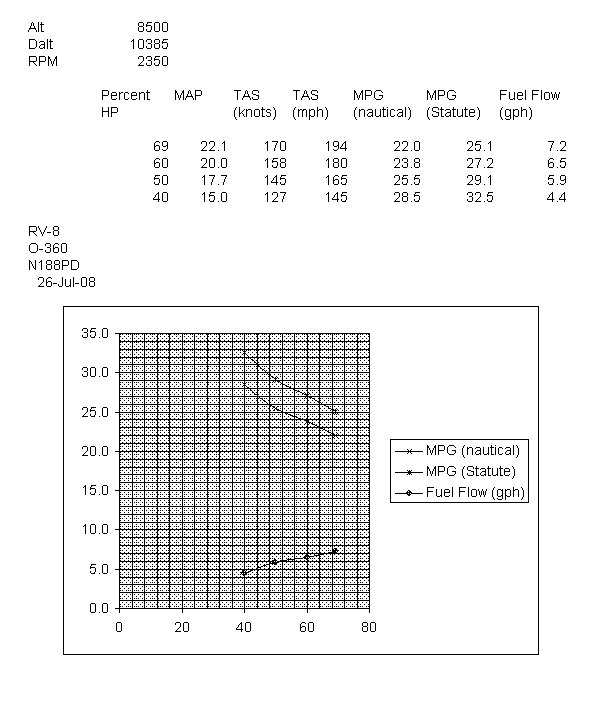Insomnia struck tonight and my mind woke up thinking.......
Why do cars and planes have such a big difference in fuel economy? It seems likely it has to be induced drag due to speed. I remember reading once that to pedal a bicycle at 28 mpg, it takes 80% of the energy required just for wind resistance.
Based on experience of a few cars at 80 mph, I've had 2 that were around 25 mpg and one had 190hp and the other 287hp. At 25 mpg at 80mph, you get a fuel burn of 3.2 gallons per hour. A 400 mile trip will take 16 gallons and 5 hours (no stops such as tickets or need for fuel).
Some of the planes I've flown have fuel burn rates far less. A PA32-260 that was about 13mpg, Bonanza S35 ~15, and C172~17. Efficiency of the plane vs the car doesn't exactly look so good. Even my wife's big SUV gets 20mpg.
I don't know about my RV7A yet, but I'm guess somewhere around 19-20 based off of gal/hr that I've picked up off of some of the posts. Maybe a smidge higher (I'm sure we'll have some posters here that can verify what the numbers are they are showing).
To travel the same trip in the RV, the distance is supposed to be about 15% shorter for the plane. The same 400 mile trip would really be ~ 350 miles. In a perfect world, at 200mph, it would take 1.75 hrs and 17.5 gallons. Just under 10% for the trip in fuel use difference. However, if the plane was able to get 25 mpg, then it should only take 14 gallons.
Similiar horsepower between cars and single engine planes. This leads me to believe that RV's are one of the most fuel efficient planes out there. No way could I get that kind of fuel economy from some of the other planes.
So....what are folks getting for actual miles per gallon?
If you don't mind, it be nice to know info such as speed, HP, fixed or CS, etc.. you might want to share.
Why do cars and planes have such a big difference in fuel economy? It seems likely it has to be induced drag due to speed. I remember reading once that to pedal a bicycle at 28 mpg, it takes 80% of the energy required just for wind resistance.
Based on experience of a few cars at 80 mph, I've had 2 that were around 25 mpg and one had 190hp and the other 287hp. At 25 mpg at 80mph, you get a fuel burn of 3.2 gallons per hour. A 400 mile trip will take 16 gallons and 5 hours (no stops such as tickets or need for fuel).
Some of the planes I've flown have fuel burn rates far less. A PA32-260 that was about 13mpg, Bonanza S35 ~15, and C172~17. Efficiency of the plane vs the car doesn't exactly look so good. Even my wife's big SUV gets 20mpg.
I don't know about my RV7A yet, but I'm guess somewhere around 19-20 based off of gal/hr that I've picked up off of some of the posts. Maybe a smidge higher (I'm sure we'll have some posters here that can verify what the numbers are they are showing).
To travel the same trip in the RV, the distance is supposed to be about 15% shorter for the plane. The same 400 mile trip would really be ~ 350 miles. In a perfect world, at 200mph, it would take 1.75 hrs and 17.5 gallons. Just under 10% for the trip in fuel use difference. However, if the plane was able to get 25 mpg, then it should only take 14 gallons.
Similiar horsepower between cars and single engine planes. This leads me to believe that RV's are one of the most fuel efficient planes out there. No way could I get that kind of fuel economy from some of the other planes.
So....what are folks getting for actual miles per gallon?
If you don't mind, it be nice to know info such as speed, HP, fixed or CS, etc.. you might want to share.





